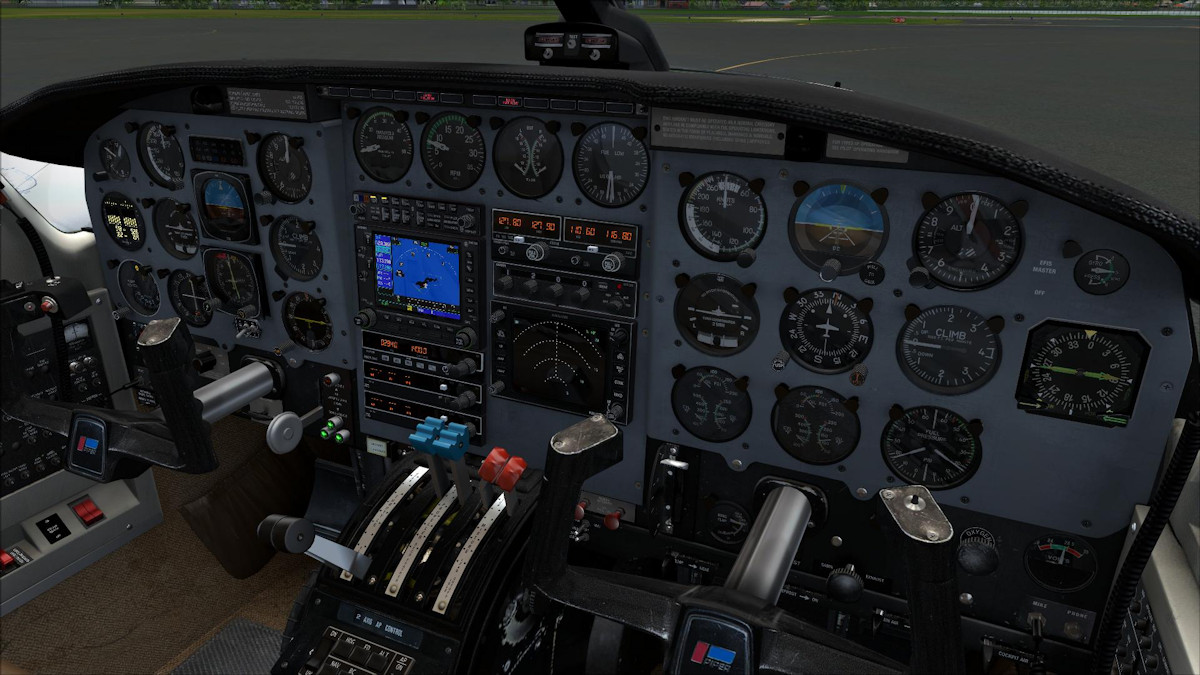Mutley's Hangar
A Haven For Flight Simulation Enthusiasts!
.jpg)
For FSX / Prepar3D Published by Carenado
Reviewed by Andrew Godden
September 2015
Introduction
Over the years, Piper has been one of the 'Big Three' in the field
of general aviation manufacturing. From its early years with the J-3
'Cub', Piper has produced some very successful single and twin
engine general aviation aircraft. The Piper PA-31 'Navajo' is a
family of cabin-class, twin-engined aircraft targeted at small scale
cargo and feeder liner operations and the corporate market.
Carenado have produced some of the best, if not the best, general
aviation aircraft for FSX / P3D. Twin piston engine models have
featured in this product range and Carenado's Piper PA-31 'Navajo'
adds further to this list and complements the aircraft category
beautifully. The PA-31 'Navajo' has been popular with private
individuals and companies and is also operated by air charter
companies and small feeder airlines. It has a reasonable range and
payload capacity, with a comfortable cruise speed.
History
The Piper PA-31 'Navajo' is a twin engine, low wing monoplane with a
conventional tail, in the general aviation aircraft category. It is
powered by a pair of Lycoming TIO-540-A, air cooled, six cylinder,
horizontally opposed, turbo-supercharged, 310 hp engines in 'tiger
shark' cowlings, a feature shared with the Piper PA-30 'Twin
Comanche' and the PA-23 'Aztec'. The PA-31 'Navajo' can have seating
for up to seven passengers and is used for passenger, utility, and
cargo purposes.
Development of the Piper PA-31 'Navajo' began in 1962 and first flew
on 30 September 1964. It was introduced in March 1967 and had an
extensive production run across 11 variants. The PA-31 'Navajo' was
also produced under licence, primarily in South America. Production
of the Piper PA-31 'Navajo' culminated in 1984, after a production
run of 3,942 aircraft.
The Carenado Piper PA-31 'Navajo' is currently available direct from Carenado and Carenado resellers as a 'download only' product (some resellers also offer a master back-up CD / DVD service for a minor additional cost). It is priced at US$37.95, or the equivalent on currency cross rates. The download file size is 369MB and it requires 940MB of HDD space for installation. An ‘activation key' is issued on purchase and is used during installation and the installation process is intuitive and seamless.
Model Features
The model features listed by Carenado for the Piper PA-31 'Navajo' are typical of models in the Carenado range and include:
• high quality 3D model;
• high definition textures;
• Carenado Garmin GNS 530 GPS unit;
• Flight1 GTN 750 integration;
• Reality XP GNS 530 integration;
• dynamic propeller shines and volumetric side view propeller effect;
• custom Lycoming TIO-540-A 3D sounds; and
• realistic behaviour.
Visual Appearance
General. The Piper PA-31 'Navajo' was designed as a passenger / corporate and utility aircraft. Carenado have modelled the initial production variant of the PA-31 'Navajo'. The modelling is excellent and highly detailed and Carenado have produced a marvellous rendition of this aircraft.
Exterior. At first glance, the Piper PA-31 'Navajo' can appear very disproportionate due to the enlarged vertical stabiliser and, along with the elongated propeller shaft and propeller spinners, and 'tiger shark' engine cowlings, it gives the aircraft a very distinctive, if not odd, appearance. Carenado have captured the essence of these distinctive features with the exacting high quality 3D model and very detailed, high definition textures. Such are the quality of the textures and detail, you can virtually see imperfections in the smoothness of various fuselage panels. The finish on the various liveries display paint chips, scratches and scrape effects to portray very real, lifelike representations of this aircraft. A comparative review of photographs of real world aircraft to Carenado's rendition reveal the exterior shape and dimensions to be very accurate and a true representation of the real world aircraft. Any noted variations were minor and are considered to be related to real world production variations or a degree of artistic licence on the part of the developer.
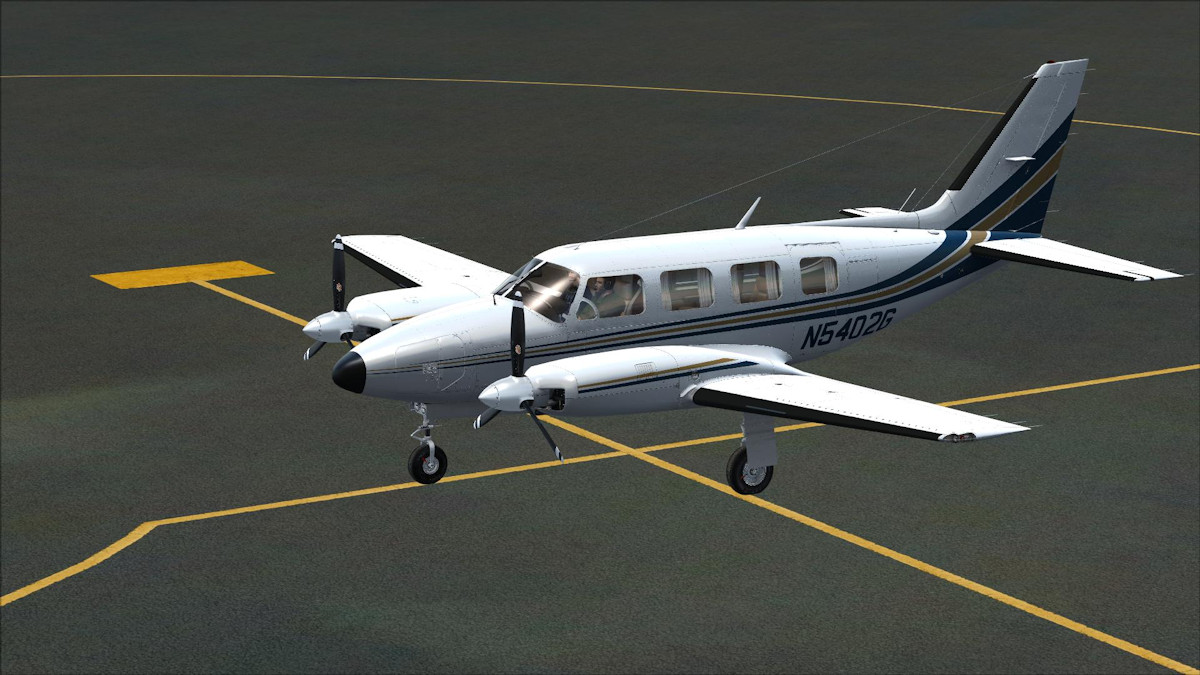 General View |
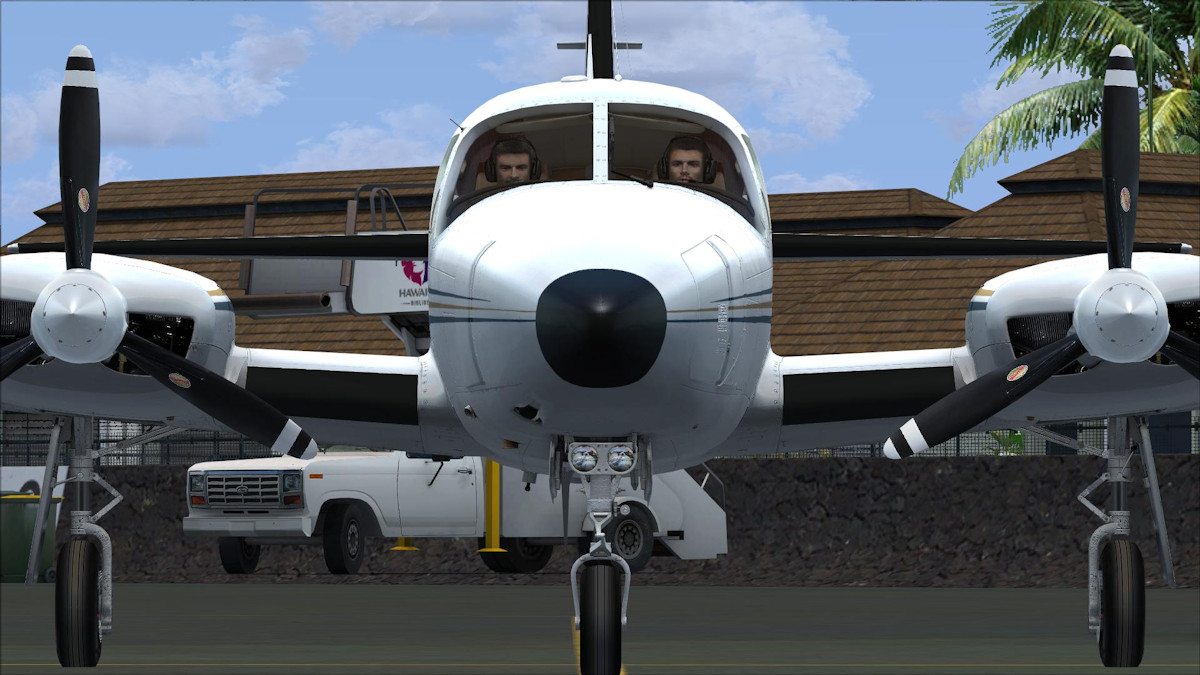 Nose View |
 Engine View |
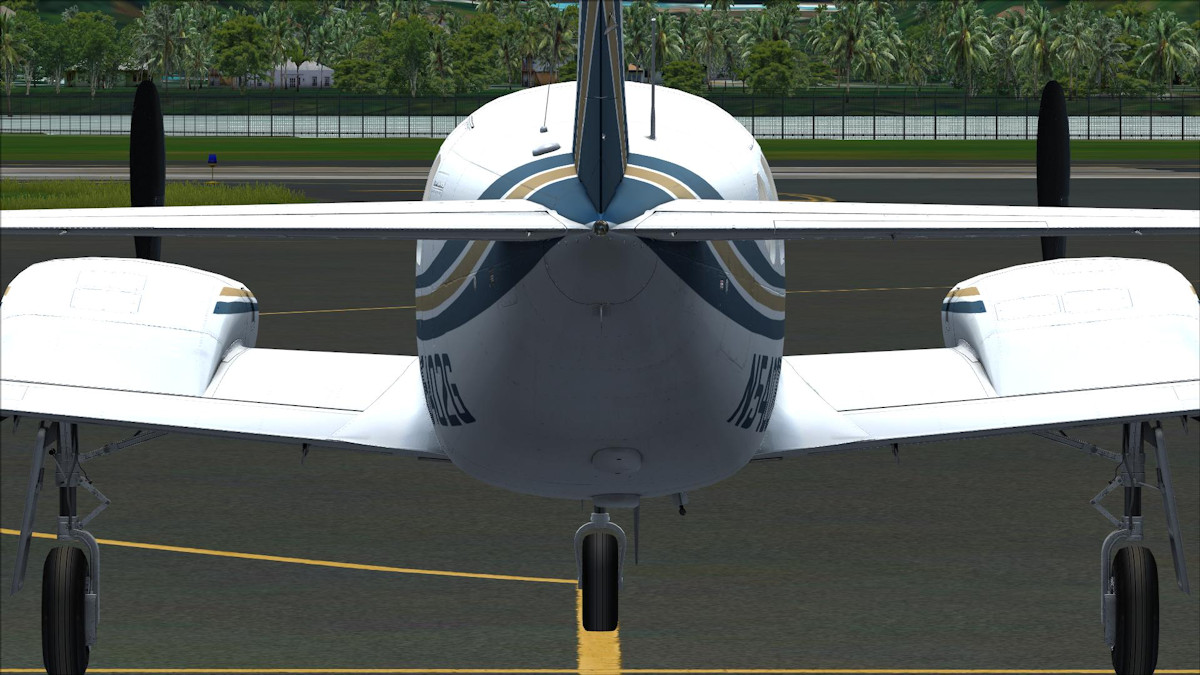 Tail View |
Flight Instruments and Systems. The cockpit of the Piper PA-31 'Navajo' is typical of Piper aircraft. The cockpit represents the typical layout for Piper aircraft and is supplemented with the Garmin GNS 530 GPS unit and Bendix/King weather radar. The standard analogue flight instruments are typical of the model range and consistent with an aircraft of this category and age. All elements of the cockpit are highly accurate and very detailed, and are clear and easy to read, with various alternative cockpit camera views available to provide more detailed clarity. Taking into account the various avionics suite fit out options available for the PA-31 'Navajo', a comparative review of photographs of real world aircraft reveal the panel layout to be a highly accurate rendition of similar real world panel layouts. There was a noted significant problem with the ADF gauge. A heading between 340 and 359 degrees cannot be set as the gauge skips through this range. A review of this gauge on other aircraft in the Carenado range revealed this problem to also be present. This indicates there is a major coding issue with this ADF gauge which has not been rectified by Carenado across a number of product releases. Even though Version 1.1 of this aircraft has been released, it did not correct this problem and there is no advice from Carenado as to when it will be rectified.
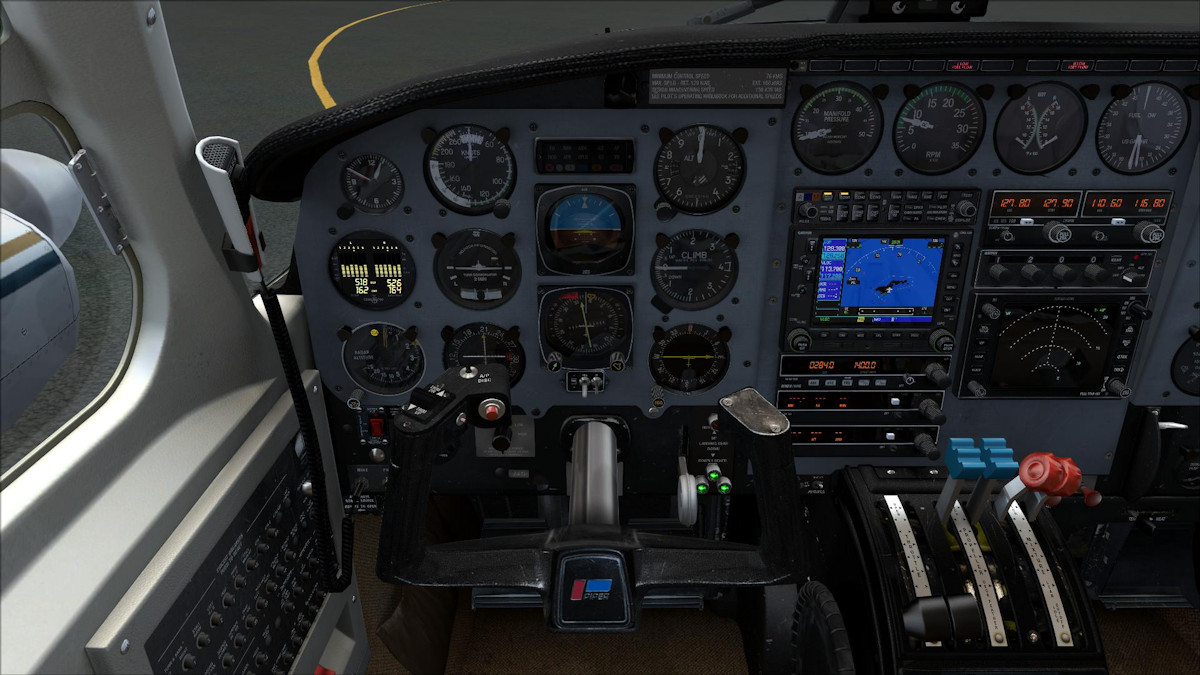 Pilot Position |
 Main Panel |
 Engine Controls & Autopilot |
 Overhead Panel |
 D-IPCH |
 N992W |
 N84372 |
 N8432D |
The animations of the primary and secondary control surfaces and other moving elements on Carenado's Piper PA-31 'Navajo' are all modelled faithfully and include:
• primary control surfaces – ailerons, elevator, and rudder;
• secondary control surfaces – flaps;
• others – rolling wheels, elevator trim tab, cabin doors open / close, cockpit windows open / close, cockpit window visors raise / lower, and
pilot chair armrests raise / lower; and
• various static elements.
 Door, Hatches, & Static Objects |
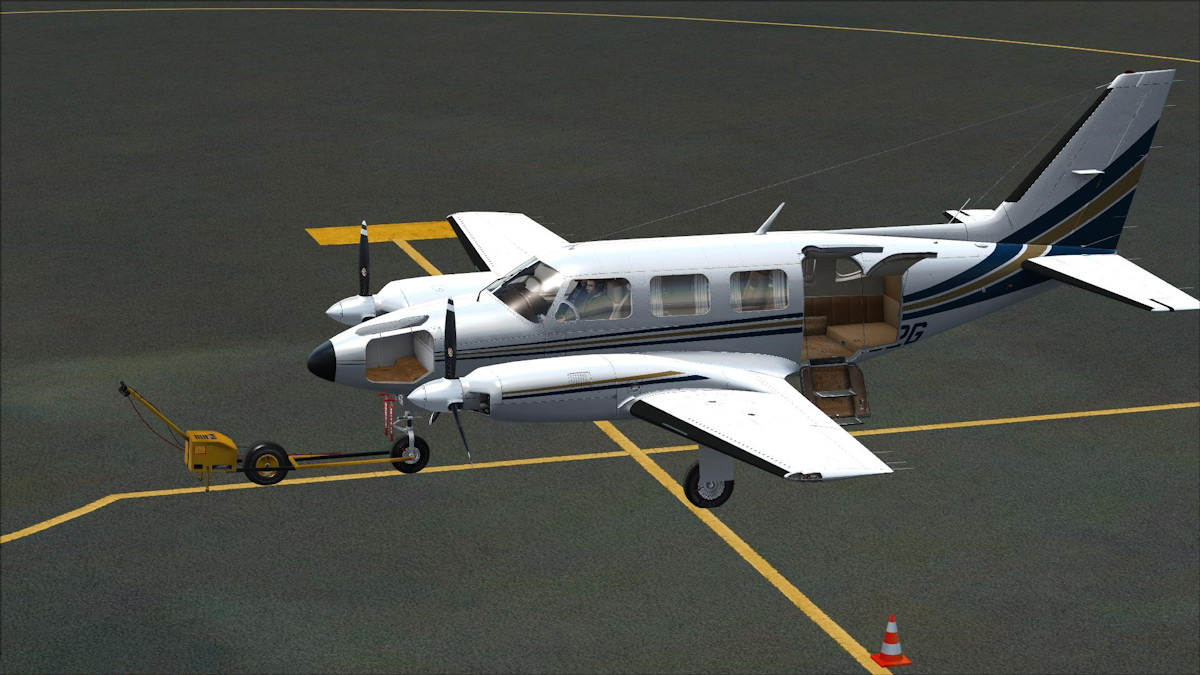 Door, Hatches, & Static Objects - 2 |
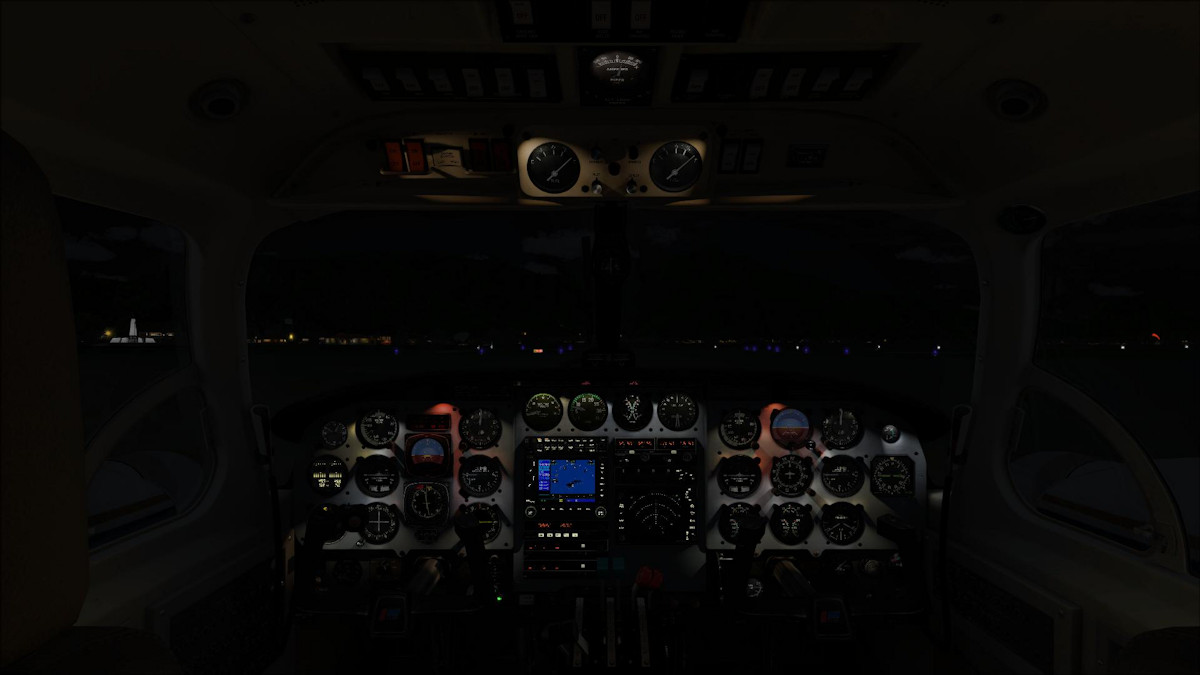 Cockpit Lighting |
 Cabin Lighting |
General Characteristics and Performance Specifications
The general characteristics and performance specifications for the Piper PA-31 'Navajo' are provided in the table. This is based on data from the official Piper PA-31 'Navajo' Pilot Operating Handbook, data provided by Carenado, and general research sources. Some of this data varies between sources and also may be an approximation due to variances in data and the specific aircraft modelled by Carenado

A specific Test Flight was conducted to test the flight performance of Carenado's Piper PA-31 'Navajo'. The flight was conducted in clear weather with a full fuel load and the aircraft at maximum take-off weight (MTOW). A cruise altitude of 10,000 ft was adopted and the route distance was particularly chosen to provide a basis upon which to test the range characteristics of the PA-31 'Navajo'. Like most aircraft of this type, adjustments must be made to fuel / pax loading to remain within the MTOW limitations.
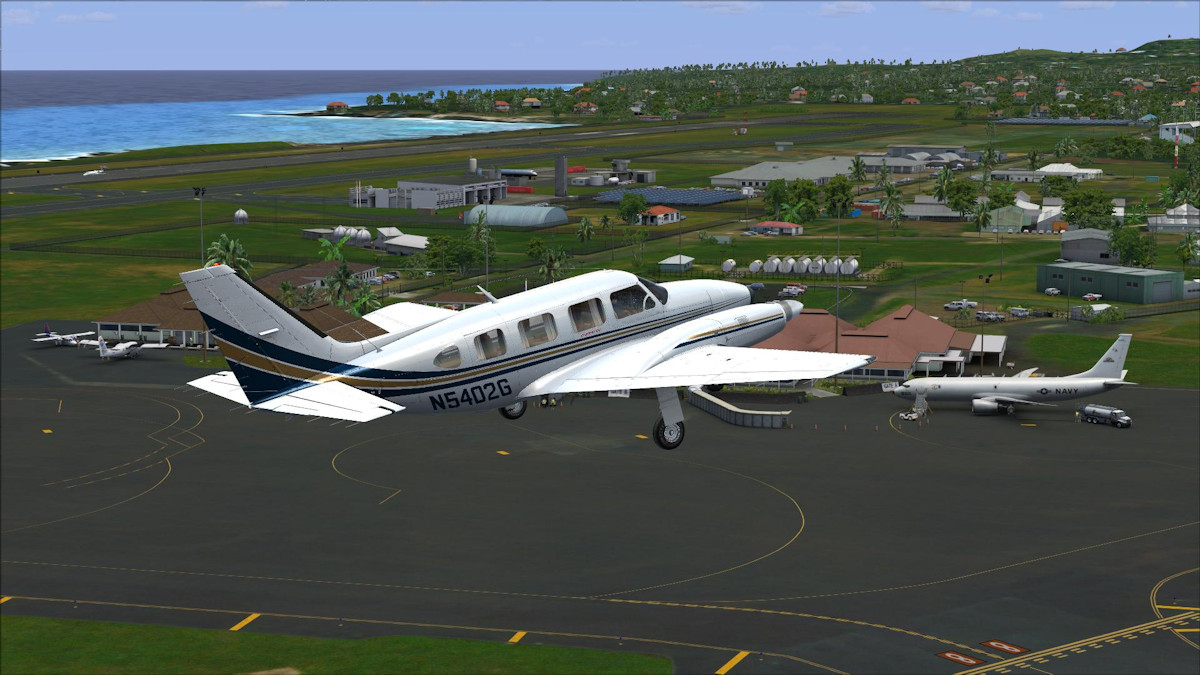 In Flight - 1 |
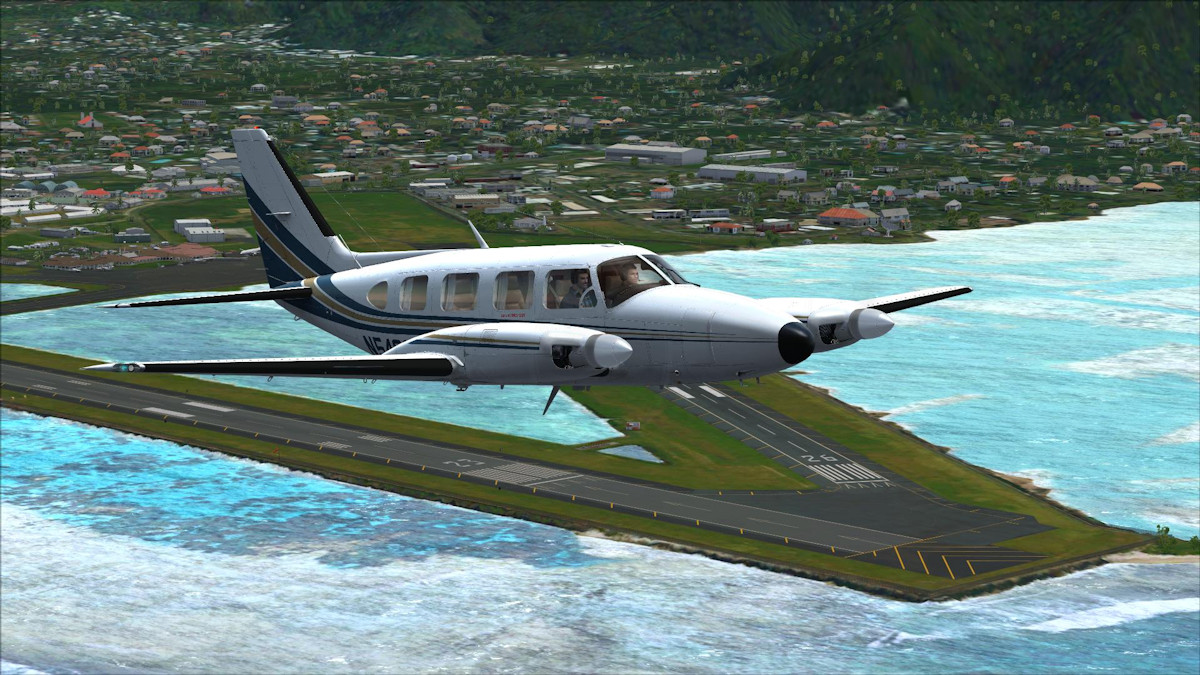 In Flight - 2 |
 In Flight - 3 |
 In Flight - 4 |
 Oil & Exhaust Stains |
 Landing Gear Operation |
In testing the accuracy of the instruments, based on the measured Test Flight, the speed indications on the airspeed indicator, were consistent with the averages measured. Additionally, when establishing a set rate of climb on the vertical speed indicator, the respective gain in altitude on the altimeter was achieved within the measured minute, and a standard rate turn was achieved within the measured two minute period using the turn coordinator.
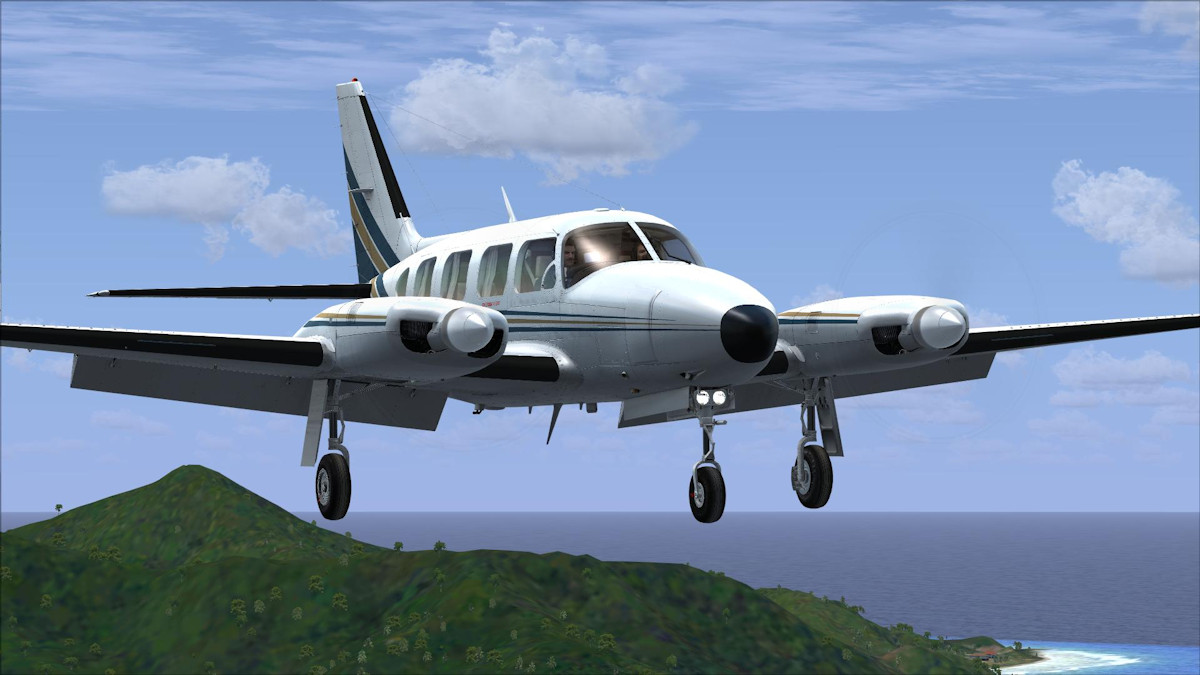 Landing Configuration - 1 |
 Landing Configuration - 2 |
Documentation
There are seven manuals / documents provided in Adobe Acrobat format (.pdf) for the Piper PA-31 'Navajo':
• Carenado GNS 530 Users Guide - this two page document details the operating of the Garmin GNS 530 GPS unit;
• Weather Radar Manual – this three page document details the operating of the Bendix/King Weather Radar;
• Normal Procedures - this 10 page manual details the procedures for the normal operation of the aircraft;
• Emergency Procedures – this 14 page manual details the emergency procedures for the aircraft;
• Performance Tables – this six page document details the performance tables for the aircraft;
• Reference - this three page document details the airspeed limitations for the aircraft; and
• Recommended Settings – this two page document details recommended display and realism settings for the aircraft.
Additional documents provide information for P3D users and information on the integration of the Reality XP GNS 530 GPS unit.
Value for Money
On a value for money assessment, the Carenado Piper PA-31 'Navajo' is considered excellent.
Simulator Performance
The aircraft model performed excellently within the existing settings I have in FSX. I have most of my settings set very high and there was no need to make any adjustments. There was no discernible frame rate impact directly attributable to the Carenado Piper PA-31 'Navajo' and FSX continued to perform smoothly.
Technical Requirements
This version of the Carenado Piper PA-31 'Navajo' is for FSX / P3D only. Other specified technical requirements are as follows:
• Windows XP (with SP3 installed), Vista, or Windows 7 (32 or 64bit);
• Microsoft Flight Simulator FSX with SP1 and SP2 installed (or Acceleration Pack) or Lockheed Martin Prepar3d Flight Simulator (v1.4 or v2.0); and
• Pentium V, 3GHz or similar, 2GB RAM (4GB RAM recommended), 512MB graphics card, and 940MB available HDD space.
Review Computer Specifications
The specifications of the computer on which the review was conducted are as follows:
• Intel i7 990X Extreme 3.46GHz;
• NVidia GTX980 G1 Gaming, 4GB, 1228/1329MHz;
• 12GB, Kingston DDR3, 2000MHz, XMP T1 CL9 HyperX;
• Windows 7, (64bit);
• Microsoft Flight Simulator FSX Acceleration; and
• additional major add-ons include: Active Sky Next, REX Essential Plus Overdrive; Ultimate Traffic 2; Orbx FTX Global BASE;
Orbx FTX Global VECTOR; Orbx FTX Global openLC EU; Orbx FTX Global openLC Alaska/Canada; Orbx FTX Trees HD; Orbx FTX region series;
and Orbx FTX airport series.
Conclusion
The Piper PA-31 'Navajo' is a beautiful aircraft which displays the Carenado hallmark traits of detail and accuracy. The identified problem with the ADF gauge is particularly disappointing as this continues to carry through from previous Carenado releases and no action has been taken to rectify it.
The ease of handling and the overall performance characteristics of the PA-31 'Navajo' make this is a fantastic aircraft, and one which will provide hours of enjoyable flying.
Verdict
Carenado have done another fine job with the Piper PA-31 'Navajo'. It is a very good product which displays a high level of quality and detail and represents excellent overall value for money.
Pros:
High Quality textures and attention to detail.
Very good documentation.
Excellent value for money.
Cons:
Malfunctioning ADF gauge.
| Scores: |
 | |
| ● External Model: | 10/10 | |
| ● Internal Model: | 8.5/10 | |
| ● Sounds: | 9.5/10 | |
| ● Flight Characteristics (does it fly by the numbers): | 9.5/10 | |
| ● Flight Dynamics (does it feel like what it looks like): | 9.0/10 | |
| ● Documentation: | 9.5/10 | |
| ● Value for Money: | 10/10 |
The Carenado Piper PA-31 'Navajo' is awarded an overall Mutley’s Hangar score of 9.4/10, with an "Highly Recommended" and a Mutley's Hangar Silver Award. |

